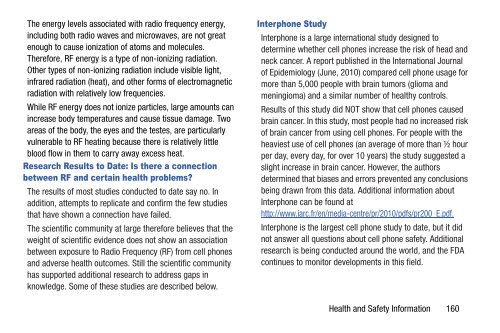Samsung Galaxy S III (Verizon) 32GB Developer Edition - SCH-I535MBCVZW - User Manual ver. LF2_F5 (ENGLISH(North America),13.79 MB)
Samsung Galaxy S III (Verizon) 32GB Developer Edition - SCH-I535MBCVZW - User Manual ver. LF2_F5 (ENGLISH(North America),13.79 MB)
Samsung Galaxy S III (Verizon) 32GB Developer Edition - SCH-I535MBCVZW - User Manual ver. LF2_F5 (ENGLISH(North America),13.79 MB)
You also want an ePaper? Increase the reach of your titles
YUMPU automatically turns print PDFs into web optimized ePapers that Google loves.
The energy levels associated with radio frequency energy,<br />
including both radio waves and microwaves, are not great<br />
enough to cause ionization of atoms and molecules.<br />
Therefore, RF energy is a type of non-ionizing radiation.<br />
Other types of non-ionizing radiation include visible light,<br />
infrared radiation (heat), and other forms of electromagnetic<br />
radiation with relatively low frequencies.<br />
While RF energy does not ionize particles, large amounts can<br />
increase body temperatures and cause tissue damage. Two<br />
areas of the body, the eyes and the testes, are particularly<br />
vulnerable to RF heating because there is relatively little<br />
blood flow in them to carry away excess heat.<br />
Research Results to Date: Is there a connection<br />
between RF and certain health problems?<br />
The results of most studies conducted to date say no. In<br />
addition, attempts to replicate and confirm the few studies<br />
that have shown a connection have failed.<br />
The scientific community at large therefore believes that the<br />
weight of scientific evidence does not show an association<br />
between exposure to Radio Frequency (RF) from cell phones<br />
and ad<strong>ver</strong>se health outcomes. Still the scientific community<br />
has supported additional research to address gaps in<br />
knowledge. Some of these studies are described below.<br />
Interphone Study<br />
Interphone is a large international study designed to<br />
determine whether cell phones increase the risk of head and<br />
neck cancer. A report published in the International Journal<br />
of Epidemiology (June, 2010) compared cell phone usage for<br />
more than 5,000 people with brain tumors (glioma and<br />
meningioma) and a similar number of healthy controls.<br />
Results of this study did NOT show that cell phones caused<br />
brain cancer. In this study, most people had no increased risk<br />
of brain cancer from using cell phones. For people with the<br />
heaviest use of cell phones (an a<strong>ver</strong>age of more than ½ hour<br />
per day, e<strong>ver</strong>y day, for o<strong>ver</strong> 10 years) the study suggested a<br />
slight increase in brain cancer. Howe<strong>ver</strong>, the authors<br />
determined that biases and errors prevented any conclusions<br />
being drawn from this data. Additional information about<br />
Interphone can be found at<br />
http://www.iarc.fr/en/media-centre/pr/2010/pdfs/pr200_E.pdf.<br />
Interphone is the largest cell phone study to date, but it did<br />
not answer all questions about cell phone safety. Additional<br />
research is being conducted around the world, and the FDA<br />
continues to monitor developments in this field.<br />
Health and Safety Information 160
















